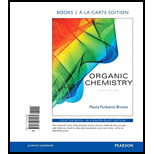
(a)
Interpretation:
The three segment of 1,4-polymerized product of 1,3-butadiene has to be drawn.
Concept introduction:
Monomers combine together to form polymers. Monomers are the repeating units of small molecules which link together to form polymers and the process is called as
Two types of polymers:
- Synthetic and biopolymers.
- DNA is an example for biopolymer and these type of polymers are synthesized by cells.
- Polymers synthesized by scientists are called
synthetic polymers and some examples are nylon, polyester etc.
Two types of synthetic polymers:
- Chain-growth
polymers or addition polymers and Step-growthpolymers or Condensation polymers. - Chain growth polymers are formed by the monomer addition to the end of a growing chain.
- Step-growth polymers are formed by combining monomers by removing small molecules of water or alcohol.
(b)
Interpretation:
The three segment of 1,2-polymerized product of 1,3-butadiene has to be drawn.
Concept introduction:
Polymers:
Monomers combine together to form polymers. Monomers are the repeating units of small molecules which link together to form polymers and the process is called as polymerization.
Two types of polymers:
- Synthetic and biopolymers.
- DNA is an example for biopolymer and these type of polymers are synthesized by cells.
- Polymers synthesized by scientists are called synthetic polymers and some examples are nylon, polyester etc.
Two types of synthetic polymers:
- Chain-growth polymers or addition polymers and Step-growth polymers or Condensation polymers.
- Chain growth polymers are formed by the monomer addition to the end of a growing chain.
- Step-growth polymers are formed by combining monomers by removing small molecules of water or alcohol.
Want to see the full answer?
Check out a sample textbook solution
Chapter 27 Solutions
Organic Chemistry, Books a la Carte Edition (8th Edition)
- 5. Complete the following condensation polymerization reactions by drawing the structural formula of the repeating unit of each polymer, as well as any other products. heat a. n HOČ(CH2)2COH + n H2NCH;CH;NH2 → b. n CIC(CH2)6CC1 + n H2NCH2CH2NH2 → heat n HOC(CH2)2COH + n HO(CH2)4OH = n CIC(CH2),CCi + n HO(CH2)½OH →arrow_forward10. Complete the following polymerization reactions. Name the polymer that forms. a) H b) H H H H H polymerize polymerize polymerize CH3 -CH-CH₂arrow_forward18. Draw the alkene monomer from which the following polymer was made. CIH CIH CI H -c-c-c-c-c-c- |||||| HHHHHH 19. Assign an IUPAC name to each of the following substituted benzene compounds. Use the ortho,- meta- and para-prefix system. (watch for toluene!) Br b. F a. Br CH₂arrow_forward
- Polypropene results from the polymerization of H H A. CH-C B. CH-C c. CH-c ĆN D. CH-C E. CH-C Multiple Choicearrow_forward4. Draw the structure of the polymer which would form when the following molecules react. (draw two units) а. CH2 HO CH2 -N-CH,-N- -CH,-CH2-C- -N-CH,-N- -CH,-CH2- CH он H.arrow_forwardDraw the structure(s) of the monomer(s) used to make each of the following polymers Define whether each polymer is a A. homopolymer or B. copolymer Define whether each polymer can be prepared by C. free radical polymerization or D. condensation polymerizationarrow_forward
- 3. Another type of Nylon can be made from 1,4-butanediamine and sebacoyl chloride: | CI - C(CH2);C –- CI H2N(CH2)4NH2 and a. Draw the structure of the polymer formed. Draw parentheses around the repeating unit. b. Is this an addition polymerization or a condensation polymerization reaction? (Circle your choice) c. What molecule will be eliminated in this reaction? d. What name (with numbers) would you give to this polymer? In the repeating unit, circle and label the amide bond. е.arrow_forward2. In your own words, explain the difference between step-reaction polymerization and chain-reaction poly- merization. What is the advantage of this terminology over the more traditional addition and condensa- tion polymerization?arrow_forward7. When asymmetric alkenes polymerize (such as chloroethene to produce PVC), the pendant group like chlorine can be arranged in different ways. An arrangement in which the -Cl groups are arranged on the same side of the polymer chain is called a(n) , a. Atactic b. Isotactic arrangement. c. Syndiotactic d. Sporadic 8. Kevlar is a type of polymer which has a great resistance to tear. Its application includes its use in making bulletproof vests and radial tires. The two monomers used to make Kevlar are the following: H H H-O- c-0-H H-N- -N-H Monomer One Monomer Two When these two monomers join a. A molecule of CO2 will be eliminated and an ester linkage will form b. Nothing will be eliminated and the two monomers will be linked through a hydrogen to hydrogen bond c. A water molecule will be eliminated and a peptide linkage will be formed d. Nothing will be eliminated. The two monomers will be linked by a carbon-carbon bond.arrow_forward
- Which general class of organic polymer are the following? A. fo B. f C. O=U f D. HIC-H H-Q-H +CH₂-CH 8=C C-N- H -CH₂-CH₂- H n condenstation addition of n (arrow_forward5. How much BPO would be needed to polymerize 2.5 g of styrene to a target molecular weight of 150,000 g/mol? 2.5 g ? g BPO n y MW = 150,000arrow_forward
 Chemistry: The Molecular ScienceChemistryISBN:9781285199047Author:John W. Moore, Conrad L. StanitskiPublisher:Cengage Learning
Chemistry: The Molecular ScienceChemistryISBN:9781285199047Author:John W. Moore, Conrad L. StanitskiPublisher:Cengage Learning Chemistry: An Atoms First ApproachChemistryISBN:9781305079243Author:Steven S. Zumdahl, Susan A. ZumdahlPublisher:Cengage Learning
Chemistry: An Atoms First ApproachChemistryISBN:9781305079243Author:Steven S. Zumdahl, Susan A. ZumdahlPublisher:Cengage Learning ChemistryChemistryISBN:9781305957404Author:Steven S. Zumdahl, Susan A. Zumdahl, Donald J. DeCostePublisher:Cengage Learning
ChemistryChemistryISBN:9781305957404Author:Steven S. Zumdahl, Susan A. Zumdahl, Donald J. DeCostePublisher:Cengage Learning
 Introductory Chemistry: An Active Learning Approa...ChemistryISBN:9781305079250Author:Mark S. Cracolice, Ed PetersPublisher:Cengage Learning
Introductory Chemistry: An Active Learning Approa...ChemistryISBN:9781305079250Author:Mark S. Cracolice, Ed PetersPublisher:Cengage Learning Principles of Modern ChemistryChemistryISBN:9781305079113Author:David W. Oxtoby, H. Pat Gillis, Laurie J. ButlerPublisher:Cengage Learning
Principles of Modern ChemistryChemistryISBN:9781305079113Author:David W. Oxtoby, H. Pat Gillis, Laurie J. ButlerPublisher:Cengage Learning





